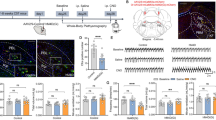Abstract
Patch-clamp experiments on transverse brainstem slices from rats were performed to study the effects of thyroliberin (10–8 M) on the membrane potential and spontaneous activity of neurons in two areas of the respiratory center: the ventrolateral area of the solitary tract nucleus and the pre-Botzinger complex. Thyroliberin induced membrane depolarization of neurons in the respiratory center and increased their spike activity. The pattern of activity of neurons in the pre-Botzinger complex showed decreases in the time intervals between the beginnings of bursts in response to thyroliberin. In some cases, thyroliberin led to the appearance of spike activity in initially “silent” neurons; “silent” neurons in the solitary tract nucleus became tonically active, while those in the pre-Botzinger complex showed burst activity. These results provide evidence for the existence of an indirect regulatory influence for thyroliberin on respiratory center neurons, operating at the membrane level.
Similar content being viewed by others
REFERENCES
A. N. Inyushkin and N. A. Merkulova, “The effects of microinjections of thyroliberin into the area of the solitary tract nucleus on respiratory and circulatory parameters,” Ros. Fiziol. Zh. im. I. M. Sechenova, 79,No. 11, 52–58 (1993).
A. N. Inyushkin, N. A. Merkulova, and S. A. Chepurnov, “The pre-Botzinger complex is involved in mediating the respiratory effects of thyroliberin,” Ros. Fiziol. Zh. im. I. M. Sechenova, 84,No. 4, 285–292 (1998).
B. Ya. Peskov and A. N. Inyushkin, “Respiratory responses during the action of thyroliberin on the ventral surface of the medulla oblongata,” Fiziol. Zh. SSSR, 76,No. 5, 637–643 (1990).
D. A. Bayliss, F. Viana, R. Kanter, C. I. Szymeczek-Seay, A. J. Berger, and D. E. Millhorn, “Early postnatal development of thyrotropin-releasing hormone (TRH) expression, TRH receptor binding and TRH responses in neurons of rat brainstem,” J. Neurosci., 14,No. 2, 821–833 (1994).
M. C. Bellingham, “Driving respiration. The respiratory central pattern generator,” Clin. Exptl. Pharmacol. Physiol., 25,No. 10, 847–856 (1998).
A. C. Bonham and D. R. McCrimmon, “Neurones in a discrete region of the nucleus tractus solitarius are required for the Breuer-Hering reflex in rat,” J. Physiol. (London), 427, 261–280 (1990).
S. A. Chepurnov and A. N. Inyushkin, “Respiratory effects of TRH microinjections into the nucleus tractus solitarii,” Neuropeptides, 26,Suppl. 1, 27 (1994).
C. L. Cream, A. Li, and E. E. Nattie, “TRH causes prolonged respiratory stimulation,” J. Appl. Physiol., 83,No. 3, 792–799 (1997).
D. de Castro, J. Lipski, and R. Kanjhan, “Electrophysiological study of dorsal respiratory neurons in the medulla oblongata of the rat,” Brain Res., 639, 49–56 (1994).
M. S. Dekin, G. B. Richerson, and P. A. Getting, “Thyrotropin-releasing hormone induces rhythmic bursting in neurons of the nucleus tractus solitarius,” Science, 229, 67–69 (1985).
C. A. del Negro, S. M. Johnson, R. J. Butera, and J. C. Smith, “Models of respiratory rhythm generation in the pre-Botzinger complex. III. Experimental tests of model predictions,” J. Neurophysiol., 86,No. 1, 59–74 (2001).
H. U. Dodt and W. Zieglgänsberger, “Visualizing unstained neurones in living brain slices by infrared DIC-videomicroscopy,” Brain Res., 537, 333–336 (1990).
G. Funk, M. A. Parkis, S. R. Selvaratnam, and C. Walsh, “Developmental modulation of glutamatergic inspiratory drive to hypoglossal motoneurons,” Respirat. Physiol., 110, 125–137 (1997).
J. Greer, Z. Al-Zubaidu, and J. E. Carter, “Thyrotropin-releasing hormone stimulates potential rat respiration in vitro,” Amer. J. Physiol., 271, R1160–R1164 (1996).
G. Hilaire and B. Duron, “Maturation of the mammalian respiratory system,” Physiol. Rev., 79,No. 2, 325–360 (1999).
A. N. Inyushkin and S. A. Chepurnov, “Central respiratory effects of TRH in ultra-low doses,” Neuropeptides, 24, 216 (1993).
S. M. Johnson, N. Koshiya, and J. C. Smith, “Isolation of the kernel for respiratory rhythm generation in a novel preparation. The pre-Botzinger complex ‘island’,” J. Neurophysiol., 85, neuron 4, 1772–1776 (2001).
N. Koshiya and J. C. Smith, “Neuronal pacemaker for breathing visualized in vitro,” Nature, 400,No. 6742, 360–363 (1999).
R. Lechan and R. Toni, “Thyrotropin-releasing hormone neuronal systems in the central nervous system,” in: Neuroendocrinology, CRC Press, London (1992), pp. 279–330.
R. B. Lunn, M. S. Kreider, and R. R. Miselis, “Thyrotropin-releasing hormone projections to the dorsal motor nucleus and the nucleus of the solitary tract of the rat,” J. Comp. Neurol., 311, 271–288 (1991).
R. A. Mueller, A. C. Towle, and G. R. Breese, “Supersensitivity to the respiratory stimulatory effect of TRH in 5,7-dihydroxytryptamine treated rats,” Brain Res., 298, 370–373 (1984).
J.-M. Ramirez and D. W. Richter, “The neuronal mechanisms of respiratory rhythm generation,” Curr. Opin. Neurobiol., 6, 817–825 (1996).
J. C. Reckling, J. Champagnat, and M. Denavit-Saubie, “Thyrotropin-releasing hormone (TRH) depolarizes a subset of inspiratory neurons in the newborn mouse brainstem in vitro,” J. Neurophysiol., 75,No. 2, 811–819 (1996).
J. C. Smith, R. J. Butera, N. Koshiya, C. Del Negro, C. G. Wilson, and S. M. Johnson, “Respiratory rhythm generation in neonatal and adult mammals. The hybrid pacemaker-network model,” Respirat. Physiol., 122, 131–147 (2000).
H. Sontheimer, “Whole-cell patch-clamp recordings,” in: Patch-Clamp Applications and Protocols, Humana Press, Totowa (1995), pp. 37–73.
Q.-J. Sun, P. Pilowsky, and I. J. Llewellyn-Smith, “Thyrotropin-releasing hormone inputs are preferentially directed towards respiratory motoneurons in rat nucleus ambiguus,” J. Comp. Neurol., 362, 320–330 (1995).
M. Thoby-Brisson and J. M. Ramirez, “Identification of two types of inspiratory pacemaker neurons in the isolated respiratory neural network of mice, J. Neurophysiol., 86,No. 1, 104–112 (2001).
W. Wang, J. K. Tiwari, S. R. Bradley, R. V. Zaykin, and G. B. Richerson, “Acidosis-stimulated neurons of the medullary raphe are serotonergic,” J. Neurophysiol., 85,No. 5, 2224–2235 (2001).
Author information
Authors and Affiliations
Rights and permissions
About this article
Cite this article
Inyushkin, A.N. Effects of Thyroliberin on Membrane Potential and the Pattern of Spontaneous Activity of Neurons in the Respiratory Center in in Vitro Studies in Rats. Neurosci Behav Physiol 34, 445–451 (2004). https://doi.org/10.1023/B:NEAB.0000022628.63964.5c
Issue Date:
DOI: https://doi.org/10.1023/B:NEAB.0000022628.63964.5c




